
Previous chapter of LEGO® Language.
Return to Richard Taylor's Home Page.
Lego Robot Ant.
Lego Christmas Models.
When we learn a language, we have to learn what the words mean and we have to learn the rules for putting the words together. The words and their meanings are known as the "vocabulary" and the rules for putting them together are called the "grammar". To learn Lego Language, we will start by looking more closely at the blocks and how they fit together.
When I first started playing with Lego blocks, there weren't as many different types as there are now. The vocabulary was much smaller. Babies use a small number of words and a lot of imagination to communicate their ideas (when I was very young, I saw Niagara Falls and exclaimed "Look, Mummy, water drip!"). Similarly, I learned to use a small number of blocks and a lot of imagination to build many things.
| The most common type of block was the 2x4. I call it a 2x4 because it has two rows of four knobs on top, but I also like to call it that because the most common type of wood for building houses is also called a 2x4. This block is easy to understand as a brick for building houses. It has roughly the same shape as a brick and can be used in a similar way. |  |
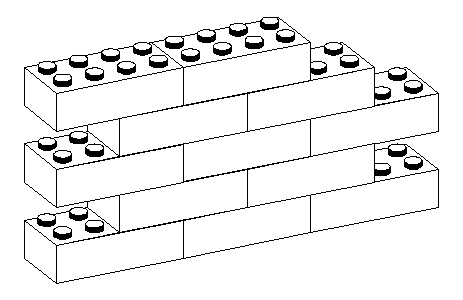
| But with a bit of imagination, it can be understood in many other ways. It can be the engine compartment or the seat of a car, |  |
it can be a step of a staircase, | 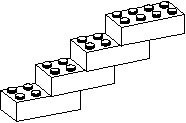 |
| it can be a nose in a face, |  |
or a foot. | 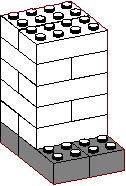 |
| It's very good at being any rectangular thing, but once you get used to the blocky language of Lego, it can pretend to be many rounded things too. | 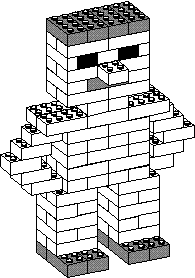 |
 |
2x4 blocks fit together in only a small number of ways (though maybe more ways than you think at first - take two 2x4 blocks and see for yourself just how many ways they can fit together). Stacking them on top of each other makes a rectangular pillar. Sometimes we need this shape, but generally it is not very strong. To make a stronger pillar, put two 2x4s side by side, then put two more on top facing across the first two. Keep building up in the same way and you will get a very strong 4x4 pillar. | 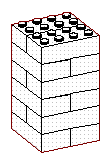 |
| If we made a wall by putting several 2x4 pillars side by side, it would break very easily. | 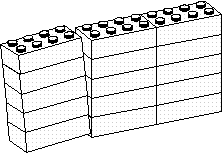 | A much stronger wall can be made using an overlapping structure. When you want to make a corner in the wall, the overlapping structure continues around the corner. | 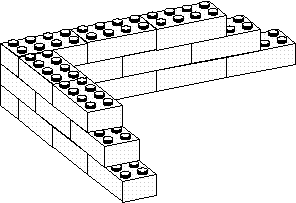 |
An interesting thing about walls made of 2x4 blocks is that you can make a complete rectangular frame using nothing else. When you want to enclose the top, you can make a kind of sloping roof by moving each row inwards by one set of knobs.
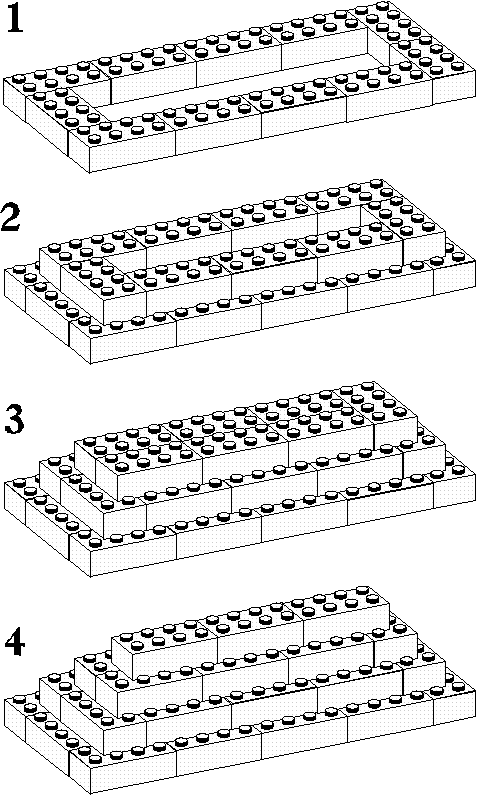
| You can build a lot of interesting things with 2x4 blocks, but often you can't finish them off without using some other kinds. You can make a nice wall with 2x4s, but you can't make a nice window or door in it. To do that, you need some 2x2s or 2x3s. | 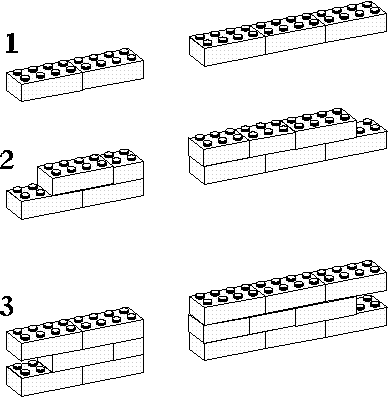 |
| The 2x2 block is half a 2x4 and is almost a cube, so it can be used in places where you want half a brick or to represent cubical things. Once again, we often find ourselves pretending that this cube is actually round as in the eyes of a face. 2x2s don't fit together with each other in very many ways, so we generally combine them with other blocks except, for example, when we need a small, square pillar like a chimney. | |
 |
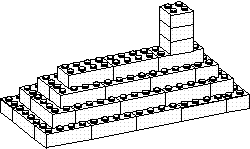 |
| I've never been very fond of 2x3 blocks because they aren't an even number of knobs long. They are useful for making uneven shapes when that's what you want, but they don't fit well into walls made of 2x4s unless you also add some 1x2s to fill the inevitable gaps.
However, it's useful to remember that two 2x3s end to end are the same length as one 2x4 and one 2x2. This comes in handy when you run out of 2x2s in the colour you're working with and you haven't quite finished the opening around the door (see above). |
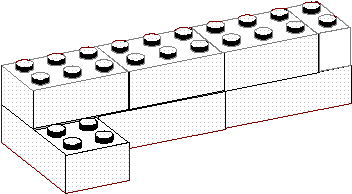 |
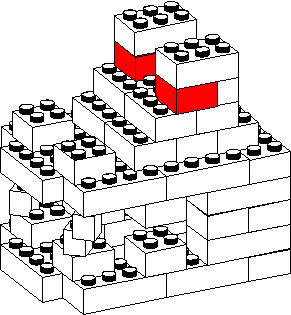 |
1x1 blocks only have one knob, so they don't hold onto other blocks very well and don't make strong structures. They can also rotate to funny positions (their sides don't always stay lined up with the other blocks). This breaks one of the basic rules of Lego Language (it's "bad grammar" not to make the sides line up), but sometimes you can break a rule of grammar to make a special point. The dragon's teeth look sharper and more menacing when the corners stick out. But you can't build Lego structures very well unless you stay rectangular (more exceptions later). |